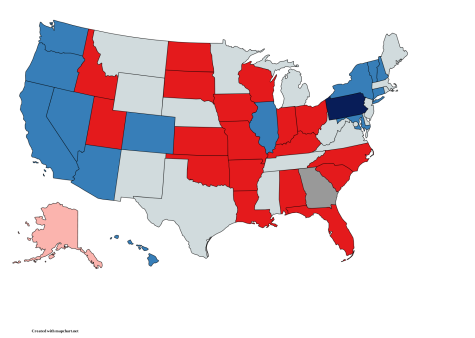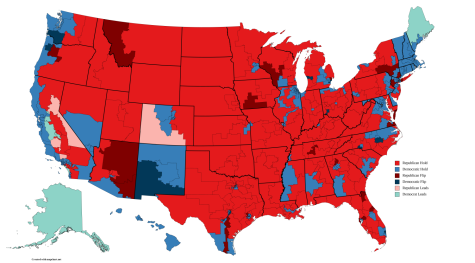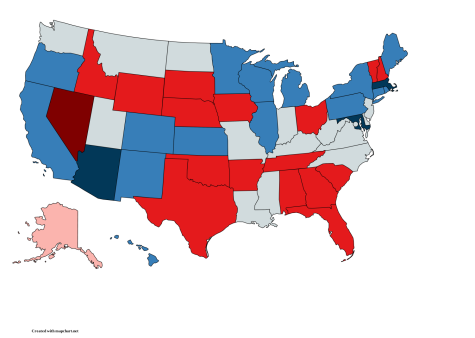‘Red wave’ becomes red ripple as Democrats overperform in midterm elections
(AP Photo/J. Scott Applewhite)
The Capitol is seen as Congress resumes following a long break for the midterm elections, in Washington, early Monday, Nov. 14, 2022.
Nov 15, 2022
On Tuesday, Nov. 8, Democrats defied historical trends and far exceeded expectations in the 2022 midterm elections, the most impressive showing by an in-power political party since 2002.
Historically speaking, midterm elections have not been kind to the party of the incumbent president in the modern age. Bill Clinton infamously lost both the House of Representatives and the Senate in massive landslides during the Republican Revolution of 1994. Barack Obama’s Democratic Party lost 63 House seats and half a dozen Senate seats in 2010. More recently in 2018, Donald Trump lost control of the House while still making modest gains in the Senate. Going into 2022, many in the political sphere, Republicans especially, saw this midterm faring similarly. They would prove ultimately to be wrong as Democrats will retain their Senate majority while Republicans will narrowly take back the House in a disappointing night for the right.
Many believed that the issue of inflation, social issues like so-called “gay and trans panic” and President Joe Biden’s current unpopularity would cause the electorate to push back against the Democratic Party and its agenda. However, it appears that Biden’s recent legislative successes, as well as the aftermath of the revocation of Roe v. Wade, helped to nearly neutralize conservative sentiment among the populace.
That said, Republicans weren’t caught completely flat-footed. They did win the House of Representatives and saw major victories across the country. Yet, one cannot argue that there was a national “red wave”, but rather results hyper-specific to certain trends and issues in certain states, which would ultimately end up largely favoring the Democrats.
Senate
Democrats entered 2022 with an incredibly narrow 50-50 majority (with Vice President Kamala Harris being the tiebreaker). With the party holding seats in once-red states like Arizona and Georgia in a seemingly right-leaning national environment, several outlets predicted that Republicans would easily reobtain the upper chamber of Congress.

However, this would not be the case as Democrats would not only defend their ground in the Senate but also slightly expand their majority. In Pennsylvania, incumbent Republican Sen. Pat Toomey was not seeking reelection. As such, the race ended up being a bellwether for the country with Democratic Lt. Gov. John Fetterman taking on TV personality Dr. Mehmet Oz. Despite many predicting that it would be a nailbiter that could swing either direction, the race was called on Election Night with Fetterman winning fairly decisively, 51%-47%, thanks in part to the Dobbs decision as well as Oz’s massive unpopularity.
In addition, incumbent Senate Democrats also saw success. In Arizona, incumbent Sen. Mark Kelly defeated his Republican challenger, Blake Masters. In New Hampshire, incumbent Sen. Maggie Hassan defeated election denier Gen. Don Bolduc by a wider-than-expected margin. Colorado’s Sen. Michael Bennet was thought to be in a tight race against Joe O’Dea but ultimately won by double-digits. Lastly, in what was considered to be a major upset, Nevada Sen. Catherine Cortez Masto defeated Republican Adam Laxalt in an election that was not called until Saturday night.
The only aspect of the Senate that remains uncertain is the Georgia election between Sen. Raphael Warnock and Heisman legend Herschel Walker which will officially go to a runoff election on Dec. 6. In contrast to the 2020 special elections, this runoff will be much less high-stakes as control of the Senate has already been decided, with the Democrats currently maintaining a 50-49 majority.
In spite of these results, it wasn’t an entirely disappointing night for Senate Republicans. Florida seemed to be one of the only states in the country where a full-on red wave actually materialized with incumbent Republican Sen. Marco Rubio defeating Democratic challenger Rep. Val Demings by a stunning 16%. Additionally, Wisconsin Sen. Ron Johnson pulled ahead in a nailbiter against Democrat Mandela Barnes, though Barnes did overperform expectations. Lastly, despite a headline-making campaign by Democrat Rep. Tim Ryan, Republican JD Vance would hold onto Ohio’s open Senate seat.
House of Representatives
In contrast to the Senate, Republicans were able to eke out a victory in the House of Representatives, if only a pyrrhic one. As of the time of this writing, House Republicans are expected to hold a 219-216 majority with a handful of seats still undecided (though these numbers are prone to changing). Though this is a majority, it is much narrower than expected and is dwarfed by previous midterm gains. This is in spite of the fact that Republicans arguably won redistricting with many red states adopting gerrymanders.

Due to all House elections being held at once, results can easily be used to measure national trends. As such, the House results show that so-called “waves” were extremely specific to individual states. For example, Michigan and Pennsylvania both saw a handful of seats go from Republican to Democrat, whereas in states like Florida, the opposite was true. In other states, like California and Oregon, Republicans were able to both hold onto traditionally Democratic seats as well as expand into blue territory, like in Oregon’s 5th congressional district. Democrats still made strides though as they dominated states like Illinois and are even on track to keep their upset gain in Alaska’s only House seat (which Democrat Mary Peltola won in a special election in August).
The most surprising results, arguably, came from New York, in which several pro-Biden House seats on Long Island and in the Hudson Valley flipped red. Many explanations exist as to why this is. Some say this is because of the use of crime rhetoric by New York Republicans; others say the results come from riding the coattails of gubernatorial nominee Rep. Lee Zeldin. Some are also pointing the finger at liberals, namely the ineptitude of Democratic Congressional Campaign Committee (DCCC) chair Sean Patrick Maloney (who was one of the New York Democrats who lost in blue seats) and the laissez-faire campaign approach of New York Democratic Party chair Jay Jacobs. Others also point to the Supreme Court striking down a pro-Democrat gerrymander. Ultimately, it seems as if the red wave in New York may have–to the surprise of some–cost Democrats the House majority.
In Ohio, however, Democrats saw some rare wins in a state Republicans otherwise dominated last Tuesday. In the Cincinnati-based 1st District, Democratic City Councilman Greg Landsman defeated longtime Republican incumbent Rep. Steve Chabot. In the 9th District, Rep. Marcy Kaptur, the longest-serving woman in House history, held her ground in a new, redder district against JR Majewski, an election denier who was accused of stolen valor. Lastly, in the Akron-based 13th District, Democratic State Rep. Emilia Sykes pulled off a mild upset against former Miss Ohio Madison Gesiotto Gilbert. These victories become much more notable when taking into consideration just how gerrymandered Ohio’s congressional map has become.
While House Republican Leader Kevin McCarthy was expected to become Speaker of the House, there were some seeds of doubt as many far-right House Republicans have expressed disdain for McCarthy and have signaled opposition against his Speaker bid. That being said, McCarthy ultimately won the nomination for Speaker on Nov. 15.
Governors
In contrast to the uncertainty of the Senate and House elections, gubernatorial races were much more orthodox, due to being less partisan compared to federal races. Incumbents fared well as only one sitting governor was defeated. In addition, with a few exemptions, the ruling party held onto power.

In Ohio, for example, popular incumbent Gov. Mike DeWine defeated challenger Nan Whaley in a landslide with many outlets calling the election exactly when the polls closed. Additionally, increasingly popular 2024 presidential pick Gov. Ron DeSantis of Florida cleaned house, demolishing Democrat Rep. Charlie Crist by 20% and winning traditionally blue areas like Miami-Dade County and the Orlando suburbs. Republican Govs. Brian Kemp of Georgia and Greg Abbott of Texas both defeated former 2018 rising Democratic stars Stacey Abrams and Beto O’Rourke respectively. In New York, despite incumbent Gov. Kathy Hochul winning, Republican nominee Lee Zeldin overperformed greatly with many partially crediting him for flipping several Democratic-held House seats in the process. Lastly, in the Republican’s only gubernatorial pickup of 2022, Clark County Sheriff Joe Lombardo defeated incumbent Gov. Steve Sisolak in Nevada.
That said, Democrats had a tremendous night as well. They would hold onto several key governorships, mainly in Illinois, Michigan, Oregon, Pennsylvania and Wisconsin. In addition, Democrats also picked up three governorships. In Massachusetts and Maryland, states that previously had liberal Republicans as their chief executives, Democrats Maura Healey (among the first lesbian governors in US history, along with Oregon’s Tina Kotek) and Wes Moore defeated Trumpian candidates to take back their deep-blue states. In Arizona, Democrats won the governorship for the first time since 2006 as Democratic Secretary of State Katie Hobbs defeated far-right former newscaster Kari Lake in a hotly contested election that wasn’t called until late Monday night.
State Legislatures
Some elections that didn’t get as many flashy headlines were the races for state legislatures which saw Democrats make massive gains. In Michigan, Democrats will control both chambers of the legislature as well as every statewide office for the first time since 1983. Democrats also look likely to take the Pennsylvania House of Representatives by a single seat. In Minnesota, Democrats took their state Senate, giving them a trifecta for the first time in eight years. Lastly, in the red state of Alaska, Democrats are poised to form coalition majorities with liberal Republicans and independents in both chambers of the legislature, giving them de-facto power in Juneau.
Ballot Issues
Lastly, it seems as if progressive ballot initiatives gained traction in 2022. Several states, including California, Michigan, Montana, Vermont and even Kentucky voted to either keep abortion legal or voted down anti-abortion state referendums. Maryland and Missouri both voted to legalize recreational marijuana by healthy margins. South Dakota became the latest state to expand Medicaid. Nevada voted to not only raise the minimum wage but also to adopt ranked choice voting, becoming the third state to do so after Maine and Alaska.
Overall, the Republican dreams of an anti-Biden “red wave” were crushed as Dobbs and other factors around the nation buoyed Democrats. The midterms will ultimately leave America in a conundrum for the next couple of years as the Democrats will control the Senate and the presidency while Republicans try to maintain a hectic, minuscule majority in the House.
Additionally, this also has implications for the future of the Republican Party as DeSantis has been picking up steam while former President Donald Trump had many hand-picked candidates crash and burn. All in all, while Republicans will likely walk away from 2022 with the House of Representatives, Democrats look as though they have ultimately bucked the midterm curse.













